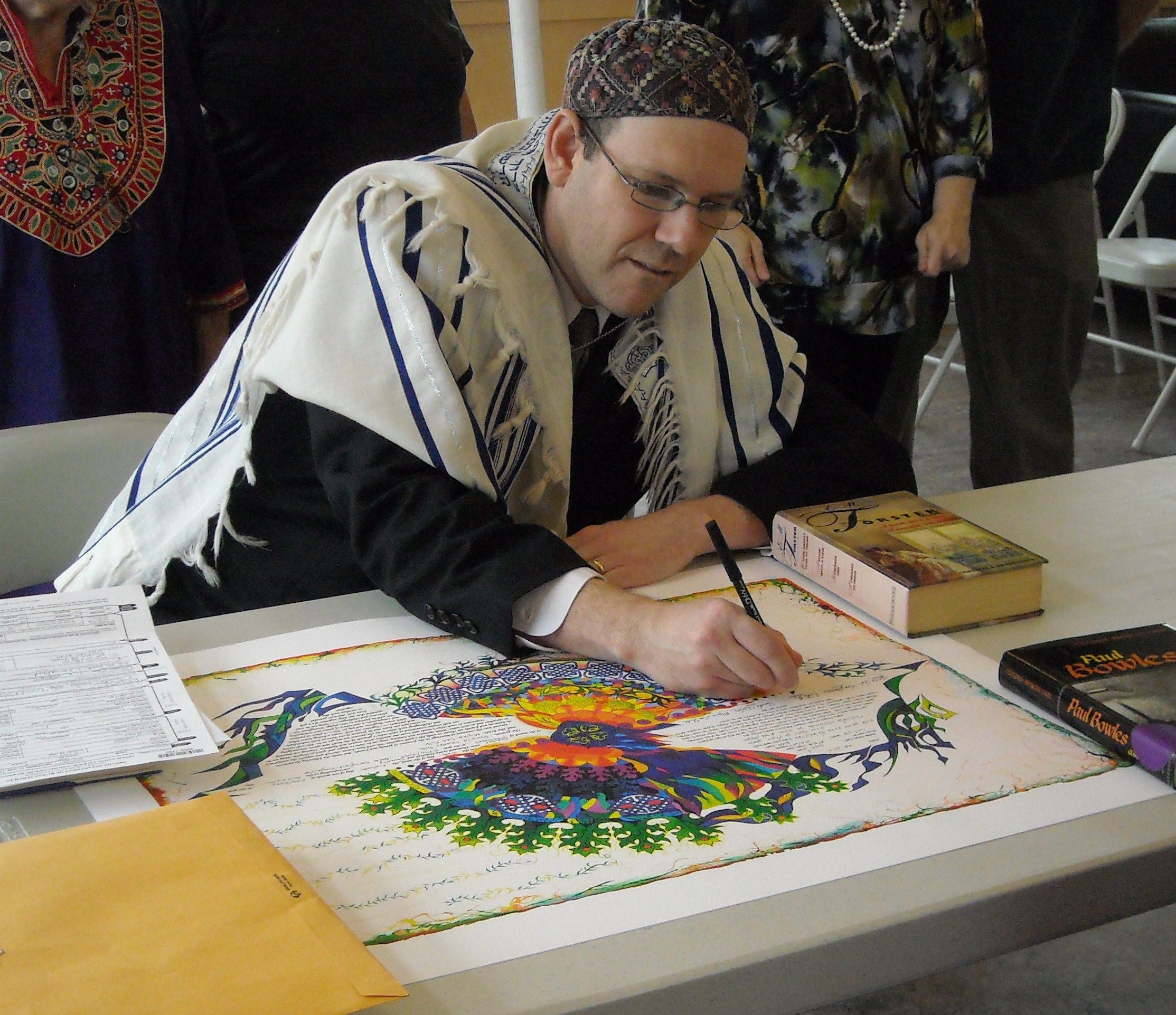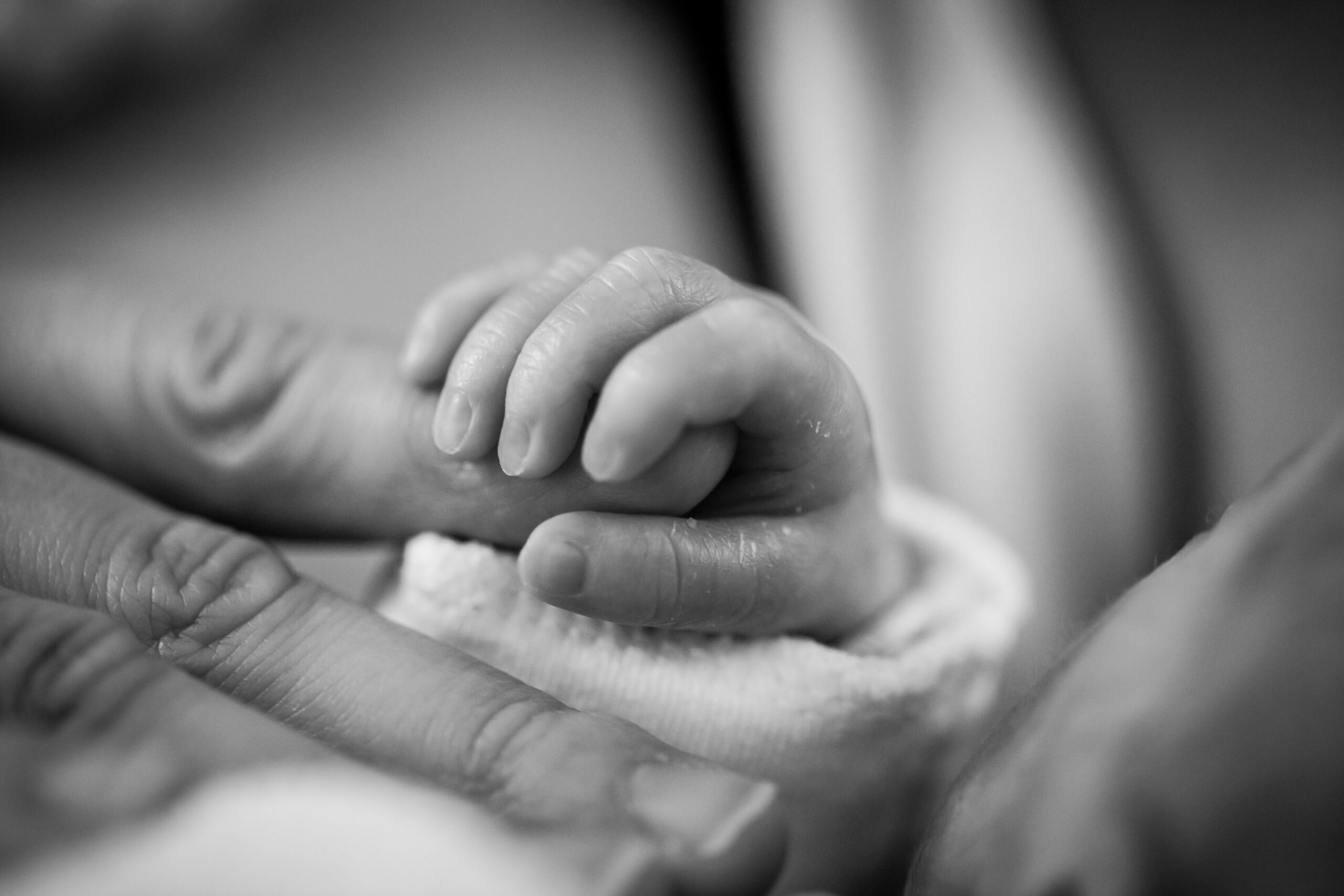Mazal tov! Congratulations! You or someone you care about have, or will soon have, a new baby in your family, and you’ve come here to learn about some of the new ways in which children are being welcomed into the Jewish community. By dipping into the ritual well you will be introduced to the idea of creating a unique ceremony especially for your family–whether you are parents by birth, through adoption, married, single, straight, gay or lesbian. Here you will find some guidelines and view sample rituals.
You may choose to create your own welcoming ceremony using what you find here as an inspiration, or adopt one from this site in its entirety. It is up to you–and that is the beauty of welcoming our children at this moment in Jewish history.
Because welcoming rituals for Jewish baby girls are a recently-developed phenomenon, borne out of the confluence of Jewish spiritual renewal and feminism a generation ago, there is no single correct way to do a welcoming ceremony, though there are elements and an order common to most.
And because this is an unprecedented moment in Jewish history, when each of us–no matter what our level of Jewish education or knowledge–has access to the essential tools of hands-on Judaism through books, articles, adult-education classes, and resources on the web, like this one, we each have the power to create welcoming ceremonies for our own children.
Brit Milah (Circumcision) and Naming Ceremonies for Girls
Naming our daughters and sons is a way of starting our new child’s future with a serious, if festive, Jewish ritual, and proclaiming our intent to raise them as joyfully engaged Jews.
Anyone can lead your welcoming ceremony. You may ask a rabbi, cantor or friend to be in charge, but it is also lovely when the parents, holding their new daughter or son in their arms, take the lead.
The brit milah (commanded circumcision) ritual has historically been regarded as a vital Jewish tradition, and the mitzvah (commandment) to honor the rite with a festive meal became an opportunity to celebrate the birth of a son and welcome him into the Jewish community.
As Jews became more sensitive to the importance of including both girls and boys, women and men, in Judaism’s most important rituals, the need to welcome our daughters with comparable ceremony led to the creation of ceremonies which are, arguably, the most influential innovation in contemporary Jewish life.
At a brit milah, in practice, the mohel (ritual circumciser) generally leads the ceremony, explaining the blessings and performing the ritual itself. As a result, the parents often have not been the hands-on “leaders” of this welcoming ritual for their son. Seeing parents lead their daughter’s ritual with her in their arms is a powerful statement about how they intend to raise their new child. The new ceremonies for daughters generally include blessings, readings, and thoughtful reflections written, chosen, and spoken by family and friends of the new baby. Among the happy consequences of these beautiful, personal ritual occasions for daughters is that families who went on to have sons felt that they wanted to welcome their baby boys with the same personal attention that they had bestowed upon their daughters. In this way, ceremonies for girls have influenced families to develop more personally meaningful ritual occasions for boys, revitalizing the brit milah.
Who Should Lead, What to Include
If you are part of a synagogue community, the rabbi or cantor will often be available to officiate or to assist in the development of a ritual to welcome your baby.
If you are looking for more than your clergy provide, or are not connected with a synagogue, you will find a few sample ceremonies here at ritualwell.org on which you may choose to model your own.
You can find many more sample ceremonies, many readings from which to choose, and a deeper and more detailed exploration of the issues involved in planning your own welcoming ritual in my new book Celebrating Your New Jewish Daughter: Creating Jewish Ways to Welcome Baby Girls– New and Traditional Ceremonies, (Jewish Lights, 2001), which is available by visiting www.jewishlights.com, and through booksellers everywhere.
History
Since Judaism’s founding father first performed his own circumcision, transforming himself from Abram into Abraham the Jew, we have marked our sons’ entry into that covenant with God in the same way.
There is no commandment in Torah to enter our daughters into the covenant, and there are two schools of thought about it among contemporary Jews. The more traditionally-oriented believe that girls are implicitly included in the covenant by dint of their Jewish birth or conversion. They also do not believe that we can add to the commanded obligations of Torah and so focus on the celebratory (rather than covenantal) elements of welcoming their daughters.
Manifesting the male-centeredness of our ancient rabbis, the Talmud also reflects a largely negative orientation toward the birth of girls.
Despite this history, Jewish communities throughout the Diaspora have long developed customs welcoming daughters, some of them dating back hundreds of years in the Judeo-Spanish world and in Central and Western Europe, though they were rarely regarded with the same religious solemnity as was brit milah.
A celebration called Las Fadas–for boys, held the night before their circumcision and for girls, at a time when the mother had recovered from the birth–dates back to medieval Spain and today is rarely practiced. New parents would invite family and friends over for Las Fadas. Each guest would take a turn holding the baby, offering blessings, hoping to fool the underworld’s “bad fairies” from feeling upset that they hadn’t been invited by “convincing” them that “good fairies” were protecting the baby with their blessings. In Turkey it was customary at Las Fadas for the mother and daughter to have an embroidered silk veil placed over their heads, lifted after the baby was formally named by the rabbi, and worn by her mother until she gave it to her daughter to wear at her wedding ceremony.
In late 16th-century Poland, in another practice, both new parents went to synagogue on the first Saturday morning after a woman had recovered from giving birth to a daughter, echoing the Biblical duty to offer a Temple sacrifice after having a baby. But as modernity and later, the Holocaust, came to those and other Jewish communities, the traditions essentially died out.
In the Sephardic community in America today, however, baby girls are welcomed with a Zeved Habat (gift of the daughter), celebrating her arrival with blessings and readings from Psalms and Song of Songs, and a lavish meal. In the United States since the early 1970s, motivated by the then-radical notion that girls and women should be included in the central rituals of Jewish life, rabbis and laypeople have delved deeply into our classical texts and cultural practices to revive, adapt, and invent new ways of acknowledging our daughters’ arrivals with the same joy and religious seriousness that we do our sons.
Those with a more liberal orientation toward tradition believe that we must enter our daughters into the covenant between God and the Jewish people just as we do our sons (but minus the physical manifestation), and employ a ritual of transition, incorporating elements like candles, a tallit (prayer shawl), or a miniature mikvah (ritual bath), to do so.
New Ceremonies: Logistics
Welcoming daughters with contemporary Jewish rituals has exploded in popularity in the last decade. Though it is not yet universally practiced, daughters’ welcoming ceremonies are held in families across the spectrum of Jewish identity—from those who tend toward the secular to those which are modern Orthodox.
These welcoming ceremonies are called by a variety of names, including Simkhat Bat (celebration of a daughter), Brit Bat (covenant of a daughter), Brit Banot Israel (covenant of the daughters of Israel), Brit Halev (covenant of the heart) and Brit Kedusha (covenant of holiness), among others. It can be held in a synagogue sanctuary, social hall, or in the parents’ or a friend’s home.
Holding your daughter’s welcoming ceremony at home or in a social hall can provide for more ritual creativity. You can still ask a rabbi or cantor to lead or participate in your daughter’s ceremony, but it also puts the choices and opportunities in your hands. And just as Jewish fathers are commanded to circumcise their sons, so too can Jewish parents take responsibility to be in charge of welcoming their daughters.
The first order of business is to decide when to hold the ceremony, since there is no fixed time for it. Some choose the 8th day of their daughter’s life, to parallel the day on which a baby boy is required to be brought into the covenant through his brit milah. Others choose the 15th day, which marks the end of the traditional two-week period of being in a ritually impure state after the birth of a daughter, according to traditional Jewish sources.
Another possibility is the 30th day, to parallel the day on which a boy, if he is the first-born child into a family which is not of the priestly class, is “redeemed” from service in Jerusalem’s holy temple through the ritual known as pidyon ha-ben. Thirty days is also the age at which Jewish children were historically counted in a census.
Another Jewishly meaningful time to hold a daughter’s welcoming ceremony is Rosh Chodesh, the celebration of a new Jewish month, which in Jewish cultures historically was regarded as a minor holiday for women and has been re-claimed, in the last three decades, as a time for Jewish women to gather and celebrate.
Many parents choose to hold their daughter’s welcoming ceremony on the first convenient Saturday or Sunday after her birth. Holding it on Shabbat, particularly if it is part of synagogue services, is nice because of the special, holy nature of the day and because this way, your entire congregational community can celebrate with you. However, doing it then may prevent religiously observant family members and friends from traveling to join you.
Holding it on a Sunday, in the late morning, is a popular option.
If you haven’t given your daughter a Hebrew name by her first birthday, that can be a nice time to hold a combination birthday party-welcoming ceremony.
If you’re having your welcoming ceremony at home it’s nice to add festive decorations like fresh flowers, balloons, or crepe paper. If your child is blessed with more than a single ethnic heritage, you may choose to incorporate visual symbols or foods of that culture, for example red tablecloths, which symbolize good fortune in China, or African kente cloth.
In whatever way you welcome your new Jewish daughter or son, doing it with a creative, personal ritual will be an experience full of holiness and joy. Remember–the power and the possibilities are in your hands. And again, Mazal Tov!
Debra Nussbaum Cohen is an award-winning journalist who is on staff at The New York Jewish Week. Her writing has appeared in Jewish newspapers all over the world, as well as in New York magazine, The Village Voice, Moment, The Jerusalem Report, and numerous other periodicals and books. She is author of the new book, Celebrating Your New Jewish Daughter: Creating Jewish Ways to Welcome Baby Girls–New and Traditional Ceremonies, which offers many more sample ceremonies, suggested readings from religious and secular sources, and an extensive discussion of the issues involved in planning a ceremony. It is published by Jewish Lights. Debra is available to come speak in your community about the phenomenon of new Jewish rituals that have been developed to celebrate birth, marriage, aging, and other important moments in the life cycle. To contact her, call: 718-623-1632 or write to her at: DnussbaumC@aol.com.













